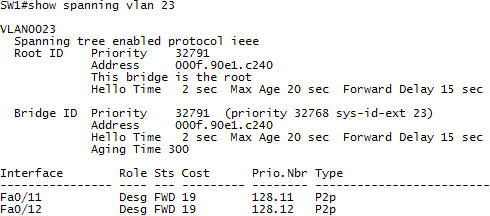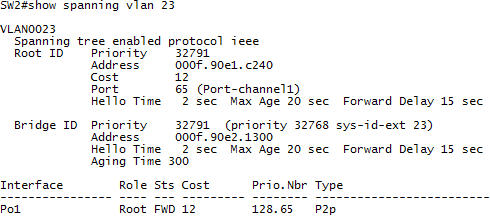[an error occurred while processing the directive]
CCNA and CCNP candidates are well-versed in Spanning-Tree Protocol, and one of the great things about STP is that it works well with little or no additional configuration. There is one situation where STP works against us just a bit while it prevents switching loops, and that is the situation where two switches have multiple physical connections.
You would think that if you have two separate physical connections between two switches, twice as much data could be sent from one switch to the other than if there was only one connection. STP doesn't allow this by default, however in an effort to prevent switching loops from forming, one of the paths will be blocked.
SW1 and SW2 are connected via two separate physical connections, on ports fast0/11 and fast 0/12. As we can see here on SW1, only port 0/11 is actually forwarding traffic. STP has put the other port into blocking mode (BLK).


While STP is helping us by preventing switching loops, STP is also hurting us by preventing us from using a perfectly valid path between SW1 and SW2. We could literally double the bandwidth available between the two switches if we could use that path that is currently being blocked.
The secret to using the currently blocked path is configuring an Etherchannel. An Etherchannel is simply a logical bundling of 2 - 8 physical connections between two Cisco switches.
Configuring an Etherchannel is actually quite simple. Use the command "channel-group 1 mode on" on every port you want to be placed into the Etherchannel. Of course, this must be done on both switches if you configure an Etherchannel on one switch and don't do so on the correct ports on the other switch, the line protocol will go down and stay there.
The beauty of an Etherchannel is that STP sees the Etherchannel as one connection. If any of the physical connections inside the Etherchannel go down, STP does not see this, and STP will not recalculate. While traffic flow between the two switches will obviously be slowed, the delay in transmission caused by an STP recalculation is avoided. An Etherchannel also allows us to use multiple physical connections at one time.
Here's how to put these ports into an Etherchannel:


Before configuring the Etherchannel, we saw individual ports here. Now we see "Po1", which stands for the interface "port-channel1". This is the logical interface created when an Etherchannel is built. We are now using both physical paths between the two switches at one time!
That's one major benefit in action let's see another. Ordinarily, if the single open path between two trunking switches goes down, there is a significant delay while another valid path is opened - close to a minute in some situations. We will now shut down port 0/11 on SW2 and see the effect on the etherchannel.


The Etherchannel did not go down! STP sees the Etherchannel as a single link therefore, as far as STP is concerned, nothing happened.
Building an Etherchannel and knowing how it can benefit your network is an essential skill for CCNA and CCNP success, and it comes in very handy on the job as well. Make sure you are comfortable with building one before taking Cisco's exams!
Chris Bryant, CCIE #12933, is the owner of The Bryant Advantage (http://www.thebryantadvantage.com), home of free CCNA and CCNP tutorials, The Ultimate CCNA Study Package, and Ultimate CCNP Study Packages. Video courses and training, binary and subnetting help, and corporate training are also available. Pass the CCNA exam with Chris Bryant, CCIE #12933! For a copy of his FREE "How To Pass The CCNA" or "How To Pass The CCNP" ebook, write to [email protected]!
 |

|
|

|









